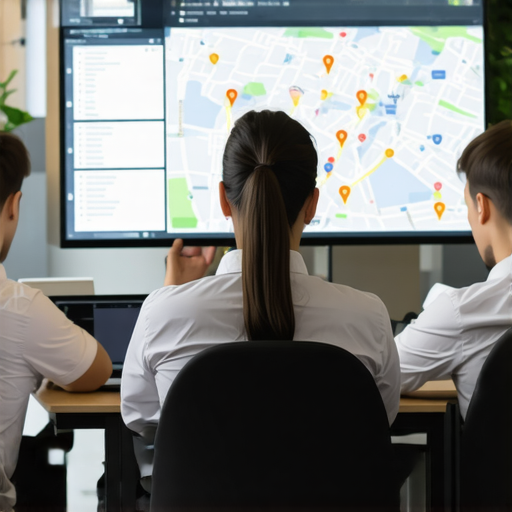My First Encounter with Local Map Visibility Challenges
I’ll never forget the moment I realized how crucial local SEO is for my small business. Despite having a fantastic product, my Google Maps listing was buried under competitors. It was frustrating, but that challenge sparked my curiosity to learn more about local map rankings and how to improve them. I started experimenting with different SEO techniques, and over time, I saw my business appear at the top of local search results. Sharing this journey, I hope to inspire others facing similar hurdles.
Understanding the Core of Map SEO and My Personal Insights
Through my experience, I discovered that optimizing your Google My Business (GMB) profile is foundational. I ensured my profile was complete, accurate, and regularly updated. Incorporating local keywords naturally into my business description and posts made a significant difference. According to Moz’s SEO guide, on-page SEO combined with local signals can boost your visibility. I also learned that consistent NAP (Name, Address, Phone number) information across all platforms builds trust with Google and customers alike.
What Are the Most Effective Techniques to Enhance Map Rankings?
From my perspective, some techniques stand out. Gathering positive reviews was a game-changer; I actively encouraged satisfied customers to leave feedback. Additionally, adding high-quality photos and videos helped my listing become more engaging. Local backlinks from community websites and directories also played a role. Recently, I explored advanced strategies like geo-targeted keywords and local schema markup, which can further enhance your profile’s relevance. For comprehensive guidance, I often refer to top Google Maps visibility strategies.
How Do I Maintain and Continuously Improve My Map Rankings?
Maintaining your position requires ongoing effort. I regularly monitor my listing’s performance with tools like Google Search Console and adjust my strategies accordingly. Engaging with customers through Q&A and responding to reviews demonstrates active management and boosts local signals. Sharing my experiences, I invite you to comment below or share your own successes—together, we can learn and grow. Remember, local SEO is not a one-time task but a continuous journey.
Leveraging Local Schema Markup for Lasting Visibility
One of the nuanced techniques I found particularly effective involves implementing local schema markup on your website. Schema markup helps search engines better understand your business details, which enhances your local relevance and can lead to richer search results. By adding specific schema types such as LocalBusiness, you signal to Google the exact nature of your services and location, reinforcing your GMB profile’s accuracy. This holistic approach to structured data not only improves rankings but also enriches your listing appearance, making it more inviting to potential customers.
How Can Consistent Engagement and Content Updates Cement Your Local Presence?
Beyond initial optimization, maintaining a dynamic online presence is crucial. Regularly updating your Google My Business posts with seasonal offers, community involvement, or new services keeps your profile fresh and signals activity to Google. Additionally, engaging with customer reviews—thanking positive feedback and addressing concerns—builds trust and encourages more interactions. This active management creates a virtuous cycle that sustains and enhances your visibility over time.
Is There an Optimal Balance Between Automation and Personalization in Local SEO?
Striking the right balance between automation and personalization is essential. While tools like review management software can streamline responses and monitor performance, human touch remains vital. Personalized replies to reviews, tailored content updates, and genuine community interactions foster stronger relationships and trust. As experts suggest, blending automation for efficiency with authentic engagement for credibility results in a resilient local SEO strategy. For deeper insights, see effective GMB optimization strategies.
What Are the Long-Term Implications of Voice Search Optimization for Local Businesses?
With the rise of voice assistants, optimizing for voice search has become an important frontier. Voice queries are often conversational and question-based, requiring your content to address typical customer inquiries comprehensively. Incorporating long-tail keywords and natural language into your GMB description and website content can position your business favorably for voice searches. This adaptation not only broadens your reach but also future-proofs your local SEO efforts, especially as voice technology continues to evolve. For innovative tactics, explore top Google Maps visibility strategies in 2024.

Illustration of a local business optimized for voice search, with voice assistant icons and keywords displayed prominently.
My Journey into the Deep Nuances of Map SEO
As I delved further into local SEO, I realized that the battlefield of Google Maps rankings is far more intricate than I initially thought. It’s not just about having a complete profile or gathering reviews; it’s about understanding and leveraging the subtle signals that search engines interpret. For instance, I discovered that Google places significant weight on behavioral metrics—how users interact with your listing, such as click-through rates and engagement time. This insight prompted me to think beyond traditional tactics and consider user experience enhancements as part of my SEO strategy.
The Power of Semantic SEO and Local Context
One breakthrough moment for me was integrating semantic SEO principles into my local strategy. Instead of keyword stuffing, I started crafting content that naturally incorporated local intent and context. For example, adding stories about community involvement or local events helped search engines associate my business with the area more authentically. According to Moz’s SEO guide, semantic relevance is crucial for ranking well in local searches. This approach made my listings feel more genuine and trustworthy, resonating with both Google and my community.
How Do I Tackle the Challenge of Evolving Algorithm Dynamics?
Keeping up with the ever-changing Google algorithms feels like trying to hit a moving target. I’ve learned that staying adaptable is essential. Regularly reviewing my insights from top Google Maps strategies helps me identify shifts in ranking factors. For example, I noticed that Google increasingly prioritizes local citations from niche directories relevant to my industry. Investing in niche-specific backlinks and community partnerships has become part of my long-term plan. The key is to treat local SEO as an ongoing process rather than a set-and-forget tactic.
Can Personalization and User Engagement Truly Sustain Rankings?
Engagement is a fascinating and often overlooked aspect. I realized that personalized interactions—responding thoughtfully to reviews, addressing concerns directly, and sharing personalized updates—foster community trust. This human touch signals to Google that my business is active and customer-centric, which can translate into better visibility. Additionally, I experimented with tailored local content, such as blog posts about seasonal events, which increased my profile’s relevance and engagement. Authenticity, I’ve found, is the currency that sustains long-term local rankings.
What Role Does Structured Data Play in Future-Proofing Your Local SEO?
Implementing local schema markup is a nuanced but powerful tactic. I’ve integrated LocalBusiness schema on my website to provide search engines with explicit details about my services, operating hours, and location. This structured data helps Google present my business more attractively in search results, with rich snippets and knowledge panels. As expert strategies suggest, schema markup is becoming increasingly vital in a competitive landscape, especially with the rise of voice search and AI-driven queries. It’s about creating an ecosystem where your website and GMB profile work seamlessly together, reinforcing your local relevance.
How Do I Balance Automation with Genuine Personal Touch?
Automation tools have their place—they help manage reviews, monitor rankings, and schedule posts efficiently. However, I have learned that genuine personal interaction is irreplaceable. Responding to reviews with sincerity and tailoring content to your community’s needs fosters trust. I now view automation as an assistant rather than a substitute for authentic engagement. For instance, automated review responses can be personalized further by adding specific details, making customers feel truly heard. This balanced approach has helped me build a resilient local presence that adapts to algorithm changes without losing its human essence.
The Future of Voice Search and Local Map Optimization
Voice search is rapidly transforming how customers find local businesses. I’ve started optimizing my content for natural language and long-tail keywords, which are more aligned with voice queries. For example, instead of just “best pizza shop,” I include questions like “Where can I find the best pizza near me?” This strategy not only broadens my reach but also prepares my business for the future. According to top strategies in 2024, integrating conversational content and local intent is essential for staying ahead in the voice search era. I encourage you to explore these tactics and share your experiences—together, we can navigate the evolving landscape of local SEO and voice technology.
Deciphering the Complex Layers of Local Map Algorithm Dynamics
As I immersed myself deeper into the intricacies of local SEO, I encountered the startling realization that Google’s algorithm for map rankings is a multi-dimensional puzzle. It’s influenced by an array of nuanced signals—behavioral metrics such as user engagement rates, dwell time on your listing, and even subtle contextual cues derived from recent user interactions. Understanding these signals demands a sophisticated analytical approach. To decode these complexities, I leverage advanced tools like cutting-edge analytics platforms that measure real-time user interactions, providing invaluable insights into what truly influences your map rankings. This knowledge empowers me to tailor strategies that go beyond conventional tactics and align with the evolving algorithmic priorities.
Integrating Semantic SEO for Hyper-Localized Relevance
One of my pivotal breakthroughs was harnessing semantic SEO principles to embed local context seamlessly into my content. Instead of relying solely on keywords, I crafted narratives around community stories, local history, and regional dialects—all naturally woven into my website and GMB profile. This approach aligns with the insights from Moz’s SEO guide, emphasizing the importance of relevance and user intent. By doing so, my business listing became a trusted local authority, resonating authentically with both search engines and the community. This depth of contextual relevance significantly elevates my visibility in hyper-local searches, especially as Google continues to prioritize genuine local engagement over superficial keyword stuffing.
Advanced Schema Markup: Creating a Robust Local Data Ecosystem
Implementing comprehensive local schema markup has been transformative in future-proofing my local SEO efforts. Beyond basic LocalBusiness schemas, I integrated specific subtypes—such as FurnitureStore and EventVenue—to precisely communicate my offerings. Additionally, I employed nested schemas to connect related entities like staff profiles, service areas, and customer testimonials. This ecosystem of structured data creates a cohesive narrative that search engines interpret holistically, resulting in richer search snippets and enhanced voice search compatibility. As I explored these advanced tactics, I found that a well-structured schema ecosystem not only boosts rankings but also significantly improves user trust and click-through rates.
Engaging in Strategic Community Collaborations
Building strategic partnerships within my local community has proved invaluable. Collaborations with local charities, sponsoring events, or participating in neighborhood initiatives generate valuable backlinks and increase my business’s local relevance. These activities are often overlooked but are highly effective in signaling authenticity and community integration to Google. Moreover, such collaborations foster ongoing engagement, which can be amplified through targeted content marketing—sharing stories, success cases, and behind-the-scenes glimpses that humanize my brand. These efforts, when consistently maintained, create a resilient local presence that withstands algorithm fluctuations and sustains top rankings.
Harnessing Voice Search Optimization for Niche Dominance
Optimizing for voice search has taken on a new dimension in my strategy. Recognizing that voice queries often involve complex, conversational questions, I tailored my content to address specific customer intents with long-tail, natural language keywords. For example, instead of generic terms, I now optimize for phrases like “Where can I find the best gluten-free bakery near me?” This approach, supported by insights from top voice search tactics, positions my business as the most relevant answer in voice-based queries. As voice technology advances, mastering this niche will be crucial for maintaining competitive dominance in local markets.
How Can I Leverage AI-Driven Personalization to Enhance Local Engagement?
In my journey, I’ve begun experimenting with AI tools that enable hyper-personalization—customized responses, dynamic content adjustments based on user behavior, and predictive engagement modeling. These innovations allow me to foster deeper connections with customers, making interactions more meaningful and aligned with individual preferences. Integrating AI-powered chatbots and review response systems, I’ve managed to maintain a human-centric approach while scaling my engagement efforts efficiently. This balance between automation and personalization is vital for cultivating long-term trust and loyalty, ultimately reinforcing my local SEO resilience. For those eager to explore these frontiers, I invite you to delve into these advanced strategies and share your experiences—together, we can pioneer the future of local map optimization.
Things I Wish I Knew Earlier (or You Might Find Surprising)
1. The Power of Behavioral Signals
Early on, I underestimated how much user engagement metrics like click-through rates and dwell time impact my map rankings. Once I started paying attention and optimizing for a better user experience, my local visibility improved significantly. It’s a subtle yet powerful signal that search engines weigh heavily.
2. Local Schema Markup Is a Game Changer
Implementing local schema on my website was initially intimidating, but it paid off. Structured data helped my business stand out with rich snippets and enhanced voice search compatibility. I wish I had started with schema earlier—it’s a subtle tweak with big results.
3. Authentic Community Engagement Matters More Than I Thought
Participating in local events, sponsoring charities, and building genuine relationships created backlinks and boosted my local relevance. It’s not just about SEO tactics but about embedding your business into the community fabric.
4. Voice Search Optimization Is the Future
Adapting my content for conversational queries and long-tail keywords opened new avenues for local discovery. It’s a space that’s evolving fast, and early adoption gives you a competitive edge.
5. Balancing Automation and Personal Touch
While automation tools help manage reviews and updates, I realized that personalized responses foster trust and loyalty. Finding that sweet spot between efficiency and authenticity is key to sustainable success.
Resources I’ve Come to Trust Over Time
- Moz’s Beginner’s Guide to SEO: This comprehensive resource demystified many complex SEO concepts and remains my go-to for foundational knowledge. It’s trustworthy and easy to follow, perfect for refining your local SEO approach.
- Google’s My Business Help Center: Staying updated with Google’s official guidelines ensures you’re aligned with current best practices. I recommend it to anyone serious about map optimization.
- Local Map SEO Experts Blog: For advanced strategies and the latest trends in Google Maps visibility, this blog is invaluable. Their insights have helped me adapt to algorithm changes effectively.
Parting Thoughts from My Perspective
Mastering local map SEO is a journey, not a one-time effort. From understanding the importance of behavioral signals to leveraging schema markup and community engagement, each element plays a role in building a resilient local presence. I’ve learned that genuine interactions and continuous learning are vital—algorithms evolve, but authentic trust remains constant. If this resonates with you, I’d love to hear your thoughts or experiences. Feel free to share this with someone who might find it helpful, and let’s keep growing our local communities together.


Reading through this post really hit home how vital consistent effort is in maintaining local map visibility. I remember struggling with similar issues when I first launched my retail store downtown. Optimizing the GMB profile was just the starting point; I soon realized the importance of actively encouraging reviews and engaging with community content to stay relevant. The part about leveraging schema markup resonated with me because I initially found it complex but later saw how it enriched my listing with rich snippets, boosting click-through rates.
One challenge I’ve faced is balancing automation with genuine personal engagement. Automated responses are efficient, but I find that personalized replies to reviews—especially addressing concerns—really foster trust and loyalty. I’d love to hear from others: what tools or practices have you found effective for maintaining authentic interactions at scale? Also, considering voice search’s growth, do you think optimizing for conversational keywords has significantly impacted your local rankings? It feels like a promising frontier for expanding reach, especially for services that benefit from more detailed inquiries.